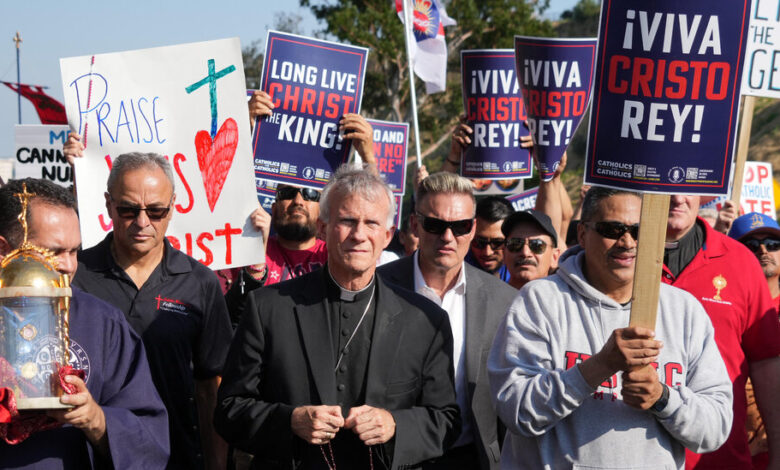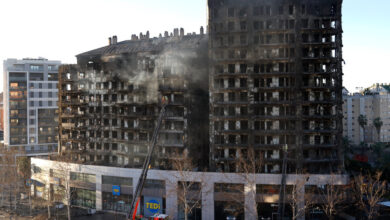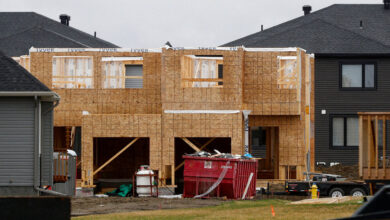
[ad_1]
Pope Francis fired on Saturday a bishop in Texas who was one of his loudest American critics within the Catholic Church, a highly rare dismissal that appeared to reflect the growing rift between the Vatican and a more conservative wing of the church.
The Vatican did not cite a reason for the dismissal of the bishop, Joseph Strickland, saying in a statement only that the pope “relieved” Bishop Strickland from the governance of his diocese in Tyler, Texas.
Bishop Strickland had significant ideological differences with Pope Francis. He was arguably the most prominent figure representing traditionalist American Catholics who see Francis as dangerously liberal on social issues like divorce, abortion and same-sex marriage, and on theological issues including his discouragement of the Latin Mass. Ultraconservatives in the United States have emerged as the financial center and media megaphone of the resistance to Francis’ papacy.
In the past year, Bishop Strickland has accused the pope of undermining the Catholic faith, questioned whether Vatican officials even qualified as Catholics and warned that the global meeting of bishops and laypeople that the pope convened last month was a vehicle to threaten “basic truths” of Catholic doctrine.
In an interview with the arch-conservative LifeSiteNews on Saturday, Bishop Strickland said he was at peace. “I stand by all the things that were listed as complaints against me,” he said, mentioning his failure to implement the pope’s 2021 document restricting the Latin Mass. A spokeswoman for the diocese declined a request for an interview with the bishop.
The dismissal followed a formal investigation by the Vatican in June into the bishop’s leadership. Neither the Vatican nor the diocese has commented on the nature or purpose of the investigation. But Cardinal Daniel N. DiNardo of the archdiocese of Galveston-Houston said in a statement that as a result of the inquiry, investigators with the church had recommended that “it was not feasible” for the bishop to remain in his post.
In a radio interview after the inquiry, Bishop Strickland compared the process to “being called to the principal’s office” and said he had nothing to hide.
Supporters of Francis, who considered Bishop Strickland’s frequent salvos against the pope beyond the pale and indicative of views that were too extreme, were likely to welcome the firing.
For some observers, the bishop’s jeremiads often went too far, even in a role whose duties include proclaiming truth.
“I don’t remember when a bishop had become so violent in his public attacks against the pope,” said Massimo Faggioli, a professor of theology at Villanova University. “He had become a real embarrassment for the church.”
Unlike the pope’s predecessors, who had censored high-ranking clergy with opposing ideological viewpoints, Francis has generally allowed dissent in the ranks in the interest of debate.
Bishop Strickland, 65 and well below the age of automatic resignation, tested the limits of that tolerance. On Oct. 31, he addressed the Rome Life Forum, a conference hosted by LifeSiteNews. He read what he described as a letter from an anonymous friend that suggested that Francis was a “usurper” in the role of pope, one who has “endangered souls by proclaiming that they are justified before God as they are, with no need of repentance.”
The speech shocked Rev. Timothy Kelly, the pastor of Holy Spirit Catholic Church in the diocese of Tyler. “How can you leave him in office after that?” he asked. “You can’t.”
Father Kelly, who has known Bishop Strickland since the 1990s, said that the bishop had grown imperious in his leadership over the past six or seven years, falling in with a group of clergy who pulled him to the right ideologically.
Conservatives moved quickly on Saturday morning to defend the deposed bishop. One hard-right organization, the Lepanto Institute, likened Francis to a “Soviet-era dictator.”
Tom Oglesby, the president of the board of the Coalition for Canceled Priests, a lay organization that supports clergy removed for what it considers unfair reasons, described Bishop Strickland in an interview as someone who “has touched people’s lives and been that light high on the hill.”
He also suggested Bishop Strickland was a “white martyr,” a concept distinguished from “red” martyrs killed for their faith. White martyrs, he said, “shed everything but blood.”
Bishop Strickland has an unusually powerful platform from which to voice his discontent with church leadership. He has a weekly radio show that is popular among conservatives, and he has more than 150,000 followers on X, the platform formerly known as Twitter. That is more even than the number of Catholics in his former diocese, which the Vatican said would now be led by Bishop Joe S. Vásquez of Austin.
The removal of a bishop from office is highly unusual but not unheard of. Francis removed Bishop Martin Holley from the diocese of Memphis in 2018 after a Vatican-led investigation into accusations of mismanagement. Pope John Paul II dismissed a French bishop in the 1990s for challenging the church’s positions on homosexuality, abortion and other social issues.
More commonly, bishops take the chance to resign. Last summer, Francis accepted the resignation of Bishop Richard F. Stika of Knoxville, Tenn., who had been sued for his handling of sexual misconduct allegations and faced internal criticism of his leadership. Bishop Strickland declined to resign, according to the statement from Cardinal DiNardo.
Bishop Strickland is a much more high-profile figure than Bishops Stika or Holley, and his removal is likelier to stir more heated debate in the American church, where influential right-wing Catholic media outlets and activist groups regularly assail Francis’ leadership.
In a live broadcast online on Saturday morning, a conservative Catholic podcaster, Taylor Marshall, speculated whether the move meant Francis was purposefully undermining the church. “What if a man were to want to be pope not to build up the body of Christ but to divide the body of Christ?” he asked.
Mr. Marshall said he had spoken to Mr. Strickland about the dismissal and said the reason was “nothing salacious or scandalous.”
The dismissal is sure to be discussed next week when the American bishops gather at their annual meeting in Baltimore, where they will elect several leadership roles. Recent announcements by the pope seemed only to deepen the division with some conservative American Catholics, whom he described recently as “reactionary.”
Recently, the Vatican made clear that transgender people can be baptized, serve as godparents and be witnesses at church weddings. The move comes at the end of a year that Francis began by condemning “unjust” laws that criminalize being gay, urging bishops to welcome L.G.B.T.Q. people into the church. Both announcements were praised by L.G.B.T.Q. advocates, although Francis has not changed core church teaching, which says “homosexual acts are intrinsically disordered.”
Francis has also cracked down on the celebration of the Latin Mass, which was celebrated for centuries until the 1960s and is experiencing a resurgence among traditionalist Catholics. Francis has characterized the Mass as divisive and said that it is too often associated with a broader denial of the goals of the Second Vatican Council, which was intended to bring the church and its rituals into the modern world.
Bishop Strickland has said that a “spiritual journey” led him to discover and revere the old Mass, which he celebrated for the first time in 2020.
Mr. Strickland is a native Texan, the sixth child born to a Catholic family who were founding members of a parish in the diocese of Tyler. He is a trained canon lawyer and has spent almost his entire career in Texas.
His diocese in East Texas, one of nearly 200 in the United States, is remote and relatively small. He was appointed to his role there by Pope Benedict XVI in 2012. The diocese sits in a deeply conservative part of the country that voted overwhelmingly for Donald J. Trump in 2020. In a statement, the diocese said that “our work as the Catholic Church in northeast Texas continues.”
[ad_2]
Source link




